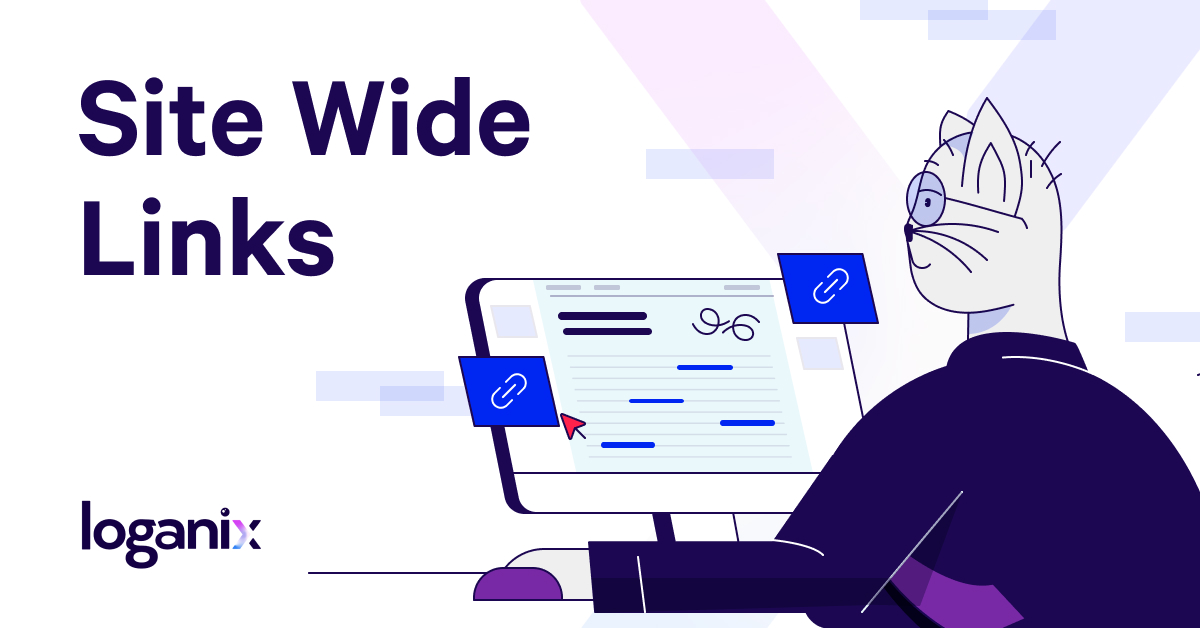What Are Sitewide Links? (+ How Do They Impact SEO Rankings?)

Hand off the toughest tasks in SEO, PPC, and content without compromising quality
Explore ServicesThe bad old days of trying to get as many backlinks as humanly possible, without regard for quality, are thankfully over. This strategy may have very temporarily helped some websites rank higher, but it was at the expense of everyone who wants to find quality content that matches their search intent on Google.
Sitewide links – links in areas that appear in every part of a site, such as in its footer – were once a popular way of trying to game the algorithm.
Should they be avoided at all costs today or are there still some beneficial ways to use sitewide links? That’s what we’ll explore today, so let’s get into it.
What Are Sitewide Links?
Sitewide links are a type of outbound links that appears throughout a whole website. The most common locations for sitewide links are the parts of a website that appear on every page, no matter where you navigate on the site.
These are the footer, sidebar, navigation menu, or header. In practice, the footer is the most common location for sitewide links because there is plenty of room for text and links in this section of a website.
Some of the most common sitewide links you’re likely to see today are outbound links to social media profiles.
Since a website can have hundreds of pages, which means that hundreds of backlinks have now been created for Facebook, Instagram, Pinterest, and Youtube.
These sites aren’t exactly in need of an SEO boost, but you can understand the thinking of shady marketers before Google cracked down on this practice: if they could secure sitewide links on a website with hundreds or even thousands of pages, that would potentially generate thousands of backlinks, rocketing their website to the top of the SERPs.
Today, the relationship between sitewide links and SEO is much more complicated.
Sitewide Links and SEO
When Google first rolled out its Penguin update back in 2012, many of these tricks that were used to unauthentically inflate search engine rankings were targeted. Websites that had been getting away with securing sitewide links to get a huge volume of backlinks were de-indexed, making them undiscoverable through Google.
Naturally, this has made people very skeptical of using sitewide links. They can send a negative SEO ranking signal to Google, which simply isn’t worth the risk.
When it comes to backlinks in general, having a huge number of links with the same link text is a red flag for Google. That’s exactly what sitewide links generate. Plus, these appear outside of any relevant context: another red flag to Google’s algorithm.
However, there are some in the SEO world who claim that it is possible for sitewide links, when used correctly, to confer some small amount of SEO benefit. Since backlinks do generally pass some link juice provided that they appear naturally, a sitewide link that isn’t part of a scheme to generate thousands of inauthentic backlinks may do the same.
In fact, Google’s own John Mueller has said that normal sitewide links that occur organically shouldn’t be of concern.
The likely truth is that naturally occurring sitewide links won’t necessarily damage the SEO rankings of the target site, but it’s also unlikely that they pass along much if any, link juice.
Benefits of Sitewide Links
Sitewide links have a role to play in user experience, and not using them at all could make things more difficult for visitors to your site.
In the example from Structube above, sitewide links to their social pages make it easier for their customers to stay connected with them and see what they’re doing on other platforms.
In some limited cases, a webmaster may genuinely wish to provide some helpful resources for visitors to their website in the form of sitewide links in their footer that can be accessed from any page.
Another common sitewide link is a link to the web designer who built a website. It’s like an artist’s signature, letting visitors who like the site and who may be looking for a web designer themselves get in touch. Plus, it’s a little bonus promotion for the designer that is generally accepted and standard throughout the internet.
These examples illustrate that sitewide links can be very beneficial from a UX perspective. Since the aim of Google’s algorithm is to deliver the best, most relevant information to users, disallowing sitewide links altogether wouldn’t make much sense.
That’s likely why the advice of Google’s John Mueller is not to worry about these links too much if they’re organic: you don’t have to disavow every link from a website that may authentically want to share your site as a resource in their footer.
However, you also shouldn’t think about sitewide links as an SEO-boosting technique. There simply isn’t much, if anything, to gain from a rankings perspective, and there is a lot to lose if you are flagged for obtaining sitewide links as part of a link-building scheme.
Sitewide Links Best Practices
To avoid damaging your hard-earned SEO rankings or, in the worst-case scenario, having your website deindexed by Google, here are some important tips and practices to keep in mind if you’re ever unsure about whether a sitewide link is okay.
Use the nofollow attribute
Google gives users a way to indicate that a link is not editorially placed. These links have the HTML tag rel=“nofollow”, as opposed to the tag rel=”dofollow”.
This tells Google not to pass any link juice to that link. Google’s bots will still crawl the link for the purpose of indexing your site and understanding what it’s about, but the tag will indicate that the link isn’t placed there for SEO purposes.
Whether you have an outbound sitewide link on your website or a different site has a sitewide link pointing to you, this tag should be used to err on the side of caution.
Nofollow sitewide links can still provide a boost in traffic from people clicking on the link, but won’t impact SEO positively or negatively.
Use branded anchor text
For most backlinking purposes, varied and descriptive anchor text is usually the right approach. That’s because varied text suggests the link is being placed naturally in a place where it helps provide value given the context. It’s good to have a backlink profile that includes lots of links with different anchor text, as opposed to one that’s full of links with your brand name as the text.
One major exception? Sitewide links.
If a website is linking to a resource in its footer and they use keyword-stuffed anchor text for the link, it looks spammy. Using the brand name or domain name is much more appropriate in this context.
Know the usual sitewide links
There are some types of links that frequently appear in footers, so you really don’t have to worry about them too much.
These include:
- Links to external policy pages, such as privacy policies
- Links to social profiles on third-party sites
- Links to web or graphic designers involved in the creation of the site
- Links to software that powers the site
- Links to sister sites or businesses with the same ownership, provided they’re related
Ensure sitewide links are natural
If the sitewide links pointing to your site contextually make sense on the website on which they appear, are helpful to visitors to that site and use your brand or site name as the anchor text, you should be okay.
Similarly, if you have sitewide links in your footer, ensure they meet the above criteria and use the nofollow tag for good measure.
Never buy sitewide links
Since the maximum SEO benefit you could derive from sitewide links, provided they’re very rare and relevant, is minimal, it is never worth buying them.
Doing so will almost certainly get you trouble with Google, undoing all of your hard work so far. It’s just not worth it, and any site that offers this service shouldn’t be trusted
Remove existing sitewide links if necessary
If a backlink audit reveals sitewide links that aren’t organic nofollow links, reach out to the webmaster to have them removed. This will generally work, but it doesn’t, there is an option within Google Search Console to disavow them.
Summary
Using sitewide links in an effort o inflate SEO rankings is a long-dead technique and a surefire way to get your website flagged by Google. However, sitewide links, when used naturally and organically to enhance the experience of visitors to a website, can provide real value. They can convey information, provide helpful resources, and make it easier to navigate to sites they will be interested in. In these cases, using sitewide links is still above board. Just don’t expect an SEO boost from them.
Instead of wasting your time on ineffective link-building tricks, let Loganix take your SEO efforts to new heights. From creating content that your readers and search engines alike will love, to scoring links on valuable, high-DA websites, we’ve got all your SEO needs covered.
Hand off the toughest tasks in SEO, PPC, and content without compromising quality
Explore ServicesWritten by Adam Steele on December 14, 2022
COO and Product Director at Loganix. Recovering SEO, now focused on the understanding how Loganix can make the work-lives of SEO and agency folks more enjoyable, and profitable. Writing from beautiful Vancouver, British Columbia.





